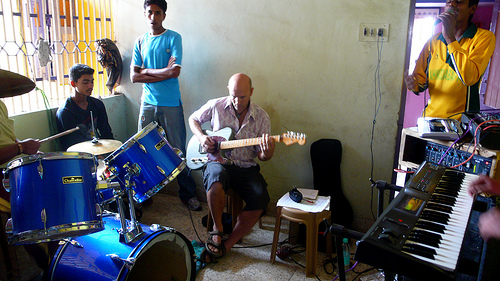
My field site for the past several years has been an urban ghetto in India. We only have time to visit for a few weeks each year, and every time we return the place has transformed itself. A planned widening of the main road could demolish hundreds of homes by the time we return next year. That’s all par for the course. New York City transforms itself each time I return home. But this year we got to experience another kind of transformation. One which I think could be of interest to any ethnographer.
Our film focuses on an acting troupe, and we’ve spent almost all of our time there talking to the actors and their families. This time, however, we were working on the sound track. We wanted to capture the local sounds and extensive musical talent within the community to make a sound track that gives a sense of place. One of our inspirations is this video for M.I.A.’s song, Bird Flu, which we feel captures something important about what it is like to be in such an urban space.
Since neither of us are particularly talented musically, we looked for some help. We were very lucky to find an excellent musician who not only has experience working on film scores (he’s worked together with my wife on other film projects), but who also has experience traveling and working in India. John Plenge doesn’t speak Hindi, but he does speak “music,” and having him there allowed us to explore the fieldsite in a whole new way. We met wedding bands, a dubbing artist who sings vocals for the Gujarati film industry, and heard folk songs sung by women at weddings. I’m not trained in ethnomusicology, but I was struck by how this musical project transformed our experience of the community. Music is always a part of life there, being blasted out of rooftop speakers every day for some wedding, festival, or just because. But not being particularly knowledgeable about music I never would have explored this aspect of life there if it hadn’t been for John.
When I studied yoga the teacher would emphasize trying to do the opposite of what you normally do: start with your left leg instead of the right, or stand on your head. These exercises are aimed at bringing greater balance to the body, like rotating the tires on your car. Although the very act of going to another country and doing ethnography can sometimes serve to shake our preconceptions, we all too easily settle into new habits in the field. Sometimes it might be good to find a way to shake things up a bit and do something which allows you to see your fieldsite in a new way.
M.I.A. has been my favorite music artist for a little over two years now, and I think her genius is the successful juxtaposition of cosmopolitan influences without ever getting labeled ‘global music.’ I’ve gotten to see her live twice, and the people who come out to see her (in the U.S. at least) are the most interesting mix of hipsters, homos, and preppy South Asian kids. I think you’ll be seeing her influence on global pop culture for a long time ahead.